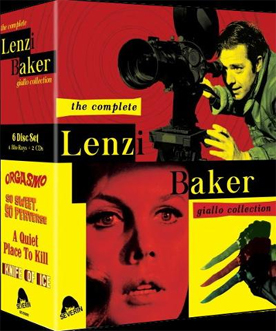 THE
COMPLETE LENZI/BAKER GIALLO COLLECTION: ORGASMO (1969)/SO SWEET…
SO PERVERSE (1969)/A QUIET PLACE TO KILL (1970)/KNIFE OF ICE (1972)
THE
COMPLETE LENZI/BAKER GIALLO COLLECTION: ORGASMO (1969)/SO SWEET…
SO PERVERSE (1969)/A QUIET PLACE TO KILL (1970)/KNIFE OF ICE (1972)Director: Umberto Lenzi
Severin Films
 THE
COMPLETE LENZI/BAKER GIALLO COLLECTION: ORGASMO (1969)/SO SWEET…
SO PERVERSE (1969)/A QUIET PLACE TO KILL (1970)/KNIFE OF ICE (1972)
THE
COMPLETE LENZI/BAKER GIALLO COLLECTION: ORGASMO (1969)/SO SWEET…
SO PERVERSE (1969)/A QUIET PLACE TO KILL (1970)/KNIFE OF ICE (1972)Fans of Umberto Lenzi's cannibal and zombie flicks may be in for a shock with THE COMPLETE LENZI/BAKER GIALLO COLLECTION's sampling of the breezy but still quite perverse side of the director's genre career.

A jobbing director who worked in every Italian genre trend from early 1960es costume pictures, westerns, and spy thrillers to 1970s gialli and Poliziotteschi, 1980s cannibal and zombie gore, not to mention a couple Joe D'Amato Filmirage pics and gorier than usual Italian TV horror movies, Umberto Lenzi's contribution to the genre was a trio of films headlining exiled Hollywood starlet Carroll Baker (GIANT) that set into motion a trend of jet-setting melodramas about human foibles leading to murder that was quite apart from Bava's body count pictures and aped by Sergio Martino and Lucio Fulci – both of whom were involved in the Romolo Guerrieri-helmed Carroll Baker giallo THE SWEET BODY OF DEBORAH before his own first stabs at the genre PERVERSION STORY and A LIZARD IN A WOMAN'S SKIN – even as their efforts made concessions to the more violent gialli of Dario Argento whose THE BIRD WITH THE CRYSTAL PLUMAGE rapidly revised the tropes of the genre (with even Lenzi's own later gialli appearing to be grudging concessions to the Argento's influence).
 In
ORGASMO, newly-widowed Kathryn West (Baker) flees to Italy away from the enmity
of her late husband's frosty relatives and bitterness over her inheriting his
fortune and business interests. She is set up in a remote villa by her infatuated
attorney Brian Sanders (Tino Carraro, WEREWOLF WOMAN) where she can get a hold
on her fragile nerves – with the help of pick-me-ups and pep pills –
and get back to her interest in painting with only stern housekeeper Teresa
(Lilla Brignone, L'ECLISSE) to keep her company. Her peace and quiet, however,
is quickly disrupted by young and handsome American layabout Peter Donovan (Lou
Castel, THE KILLER NUN) whose car breaks down outside the villa, leading to
the offer of hospitality for a night that ends up with the two of them together
in the shower. Just as Kathryn has become resigned to being a sugar mama, Peter
brings his equally adventurous bisexual sister (or is that half-sister or stepsister)
Eva (Colette Descombes, YOUR HANDS ON MY BODY) into the picture and into bed
with the two of them. When Kathryn attempts to rid herself of the pair only
for them, they return with incriminating photos of her drugged bedroom activities.
They claim they do not want money, they only want her; but she soon becomes
a prisoner in her own home and their motives appear even more sinister.
In
ORGASMO, newly-widowed Kathryn West (Baker) flees to Italy away from the enmity
of her late husband's frosty relatives and bitterness over her inheriting his
fortune and business interests. She is set up in a remote villa by her infatuated
attorney Brian Sanders (Tino Carraro, WEREWOLF WOMAN) where she can get a hold
on her fragile nerves – with the help of pick-me-ups and pep pills –
and get back to her interest in painting with only stern housekeeper Teresa
(Lilla Brignone, L'ECLISSE) to keep her company. Her peace and quiet, however,
is quickly disrupted by young and handsome American layabout Peter Donovan (Lou
Castel, THE KILLER NUN) whose car breaks down outside the villa, leading to
the offer of hospitality for a night that ends up with the two of them together
in the shower. Just as Kathryn has become resigned to being a sugar mama, Peter
brings his equally adventurous bisexual sister (or is that half-sister or stepsister)
Eva (Colette Descombes, YOUR HANDS ON MY BODY) into the picture and into bed
with the two of them. When Kathryn attempts to rid herself of the pair only
for them, they return with incriminating photos of her drugged bedroom activities.
They claim they do not want money, they only want her; but she soon becomes
a prisoner in her own home and their motives appear even more sinister.

Released in the United States under the less salacious title PARANOIA but with an X-rating and some additional extended nude shots of Baker, ORGASMO is tame stuff now but was quite racy at the time what with a Hollywood starlet indulging in drugs and implied lesbianism; and, indeed, knowing something of the circumstances that lead to Baker fleeing the states for the continent, part of the thrill of watching the film is imagining how different Rome must have seemed to the actress just getting out of a bad marriage and a lawsuit against Paramount regarding her contract. Although Castel had some arthouse pedigree, his low-key bad boy does not seem magnetic enough, while Descombes with her boyish haircut and sharp features does manage to convey a certain childish maliciousness. It is Baker, however, who makes the triangle truly unseemly by playing a character who craves being "dirtied" by characters with fewer hang-ups. It is actually easy to forget this is a thriller until the ending with multiple twists (a major one of which was snipped out of the American version making the fates of three major characters seem rather arbitrary). Lenzi and cinematographer Guglielmo Mancori (WEB OF THE SPIDER) contrast some stately Techniscope compositions of London, Rome, the Italian countryside and the villa environs with more subjective and druggy views utilizing the familiar kaleidoscope filters and POV shots through foreground glasses of J&B. The jazzy score of composer Piero Umiliani (BABA YAGA) includes the unforgettable "Just Tell Me" by Wess and the Airdales, the earworm quality of which is deliberate as it is used to drive Kathryn into a rage. Lenzi semi-remade the film as AN IDEAL PLACE TO KILL, flipping the scenario with the youthful lovers having to take their hostess hostage when they discover that she is trying to frame them for her husband's murder.
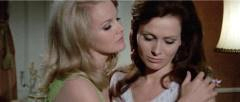 In
SO SWEET… SO PERVERSE, Baker is top-billed but the protagonist is playboy
Parisian industrialist Jean (Jean-Louis Trintignant, A MAN AND A WOMAN) for
whom thrills are getting hard to find even though he is cheating on his frosty
wife Danielle (Erika Blanc, THE DEVIL'S NIGHTMARE) with Helene (Helga Line,
NIGHTMARE CASTLE), the wife of business associate Valmont (Giovanni Di Benedetto,
THE GIRL WHO KNEW TOO MUCH); so much so, that he cannot resist an enigmatic
damsel-in-distress when Nicole (Baker) moves into the apartment above his own
and is victimized by brutal lover Klaus (Horst Frank, EYE IN THE LABYRINTH).
In his attempt to be a gallant protector, Jean falls for the troubled Nicole
who is just recovering from a nervous breakdown and admits to still being mentally
dominated by Klaus. Nicole apparently returns his feelings when she confesses
to being bait in a murder-for-hire plot in which Jean is to be the victim.
In
SO SWEET… SO PERVERSE, Baker is top-billed but the protagonist is playboy
Parisian industrialist Jean (Jean-Louis Trintignant, A MAN AND A WOMAN) for
whom thrills are getting hard to find even though he is cheating on his frosty
wife Danielle (Erika Blanc, THE DEVIL'S NIGHTMARE) with Helene (Helga Line,
NIGHTMARE CASTLE), the wife of business associate Valmont (Giovanni Di Benedetto,
THE GIRL WHO KNEW TOO MUCH); so much so, that he cannot resist an enigmatic
damsel-in-distress when Nicole (Baker) moves into the apartment above his own
and is victimized by brutal lover Klaus (Horst Frank, EYE IN THE LABYRINTH).
In his attempt to be a gallant protector, Jean falls for the troubled Nicole
who is just recovering from a nervous breakdown and admits to still being mentally
dominated by Klaus. Nicole apparently returns his feelings when she confesses
to being bait in a murder-for-hire plot in which Jean is to be the victim.

The precursors of the pre-Dario Argento jet set-set gialli is attributed by various contributors to this box set to include the breezy, sexy French thrillers of Rene Clement and Claude Chabrol along with the plot machinations of LES DIABOLIQUES (also a major influence on the Hammer cycle of thrillers from earlier in the decade). The influence was more obvious in THE SWEET BODY OF DEBORAH than ORGASMO, but SO SWEET… SO PERVERSE is the more obvious bridge between the Clouzot film and Sergio Martino's THE STRANGE VICE OF MRS. WARDH which had begun life as a Carroll Baker-style giallo before Martino added a parallel story of a razor-wielding sex maniac as much as a concession to the commercial success of Argento's THE BIRD WITH THE CRYSTAL PLUMAGE as it was a way of making the familiar plot more diverting. Here, we have Baker assailed by memories of an abusive relationship that she admits to enjoying – the sadomasochistic aspect is less pronounced but evident – while the third act involves a character who may or may not be dead preying on the guilt of a character that turns out to be more weak-willed than once appeared. Baker's damsel is more of a red herring, but front and center Trintignant – who had also appeared in the arty gialli DEADLY SWEET from Tinto Brass and DEATH LAID AN EGG from Giulio Questi – has a knack for conveying a touch of perversity that makes believable the risks he takes for what he thinks could be love. In spite of the multiple twists the third act takes, the extended absence of one of the main characters is a detriment even as we wait for their surprise reappearance (and seem to get it in a bit of trickery where a scene precedes as normal only to gradually become apparent that it is a flashback). The ending, however, is almost humorous in its pessimism. Lenzi and cinematographer Mancori are more adventurous here with the Paris setting, colorful costume design, and quirky supporting characters like Beryl Cunningham's (THE WEEKEND MURDERS) sexpot model who is the centerpiece of a party sequence talking to the camera and stripping down to butterfly pasties to the groovy scoring of Riz Ortolani (THE VIRGIN OF NUREMBERG). The J. Vincent Edward theme song "Why?" is the superior effort compared to the ORGASMO pieces, and much of Ortolani's score would be recycled and augmented with some new cues for Lenzi's later SEVEN BLOOD-STAINED ORCHIDS.
 In
A QUIET PLACE TO KILL, confusingly titled PARANOIA in Italy, racecar driver
Helen (Baker) is in a bind after surviving a crash, having drained her bank
account for her hospital stay and owing money to her sponsors for the wrecked
car, when she receives an invitation from ex-husband Maurice (Jean Sorel, THE
FOX WITH THE VELVET TAIL) to his villa in Mallorca. Helen accepts the invitation
on impulse – despite trying to kill Maurice when he left her for another
wealthier woman – and discovers that he has indeed remarried to wealthy,
older Constance (Anna Proclemer, ILLUSTRIOUS CORPSES). Helen is bewildered by
Constance's hospitability even as she seems to closely observing the interactions
between her husband and his ex-wife. It turns out that she is all too aware
of Maurice's playboy ways and suspects that he is about to leave her for another
moneyed prospect. Constance offers Helen a hundred-thousand dollars to help
her murder Maurice, but Helen's judgment is clouded by her burgeoning feelings
for her ex and the plot is further complicated by the return of Constance's
teenage daughter Susan (Marina Coffa), the penchant of family friend Dr. Webb
(Alberto Dalbes, THE DEMONS) for pointing his 8mm camera zoom lens where it
is not welcome, and the amateur sleuthing habits of local judge Jaime Dolenz
(Luis Dávila, THE TWO FACES OF FEAR).
In
A QUIET PLACE TO KILL, confusingly titled PARANOIA in Italy, racecar driver
Helen (Baker) is in a bind after surviving a crash, having drained her bank
account for her hospital stay and owing money to her sponsors for the wrecked
car, when she receives an invitation from ex-husband Maurice (Jean Sorel, THE
FOX WITH THE VELVET TAIL) to his villa in Mallorca. Helen accepts the invitation
on impulse – despite trying to kill Maurice when he left her for another
wealthier woman – and discovers that he has indeed remarried to wealthy,
older Constance (Anna Proclemer, ILLUSTRIOUS CORPSES). Helen is bewildered by
Constance's hospitability even as she seems to closely observing the interactions
between her husband and his ex-wife. It turns out that she is all too aware
of Maurice's playboy ways and suspects that he is about to leave her for another
moneyed prospect. Constance offers Helen a hundred-thousand dollars to help
her murder Maurice, but Helen's judgment is clouded by her burgeoning feelings
for her ex and the plot is further complicated by the return of Constance's
teenage daughter Susan (Marina Coffa), the penchant of family friend Dr. Webb
(Alberto Dalbes, THE DEMONS) for pointing his 8mm camera zoom lens where it
is not welcome, and the amateur sleuthing habits of local judge Jaime Dolenz
(Luis Dávila, THE TWO FACES OF FEAR).

A QUIET PLACE TO KILL is more conventionally-plotted than ORGASMO and SO SWEET… SO PERVERSE, and yet it is probably the most enjoyable film of the set. Baker is once again the compromised audience surrogate, a relative innocent but quite corruptible when money or love are involved, and her increasingly paranoiac reactions are motivated by plot machinations rather than mental illness or the ambiguity resulting from the script withholding facts about the character for the third act twist. Handsome Sorel is quite effective as the arrogant playboy who could easily drive a spurned lover to want to kill him – not the first or last time he would be in the giallo genre – and this is one of the films where one does not have to know the ending for the sometimes psychologically irrational behavior to make sense in retrospect. One of the climactic bits of action is telegraphed very early on while the final sting in the tail is contrived in its timing but very fitting to the villains. Gregorio García Segura (THE ICEBOX MURDERS) is credited with the score but that may be Spanish co-production quota credit since Piero Umiliani co-wrote the theme song "You" sung by Shirley Harmer and is also credited for the few tracks from the film on the track listing for Severin's CD soundtrack in the boxed set. Cinematographer Mancori – with Aristide Massaccesi AKA Joe D'Amato operating the camera – makes more judicious use of zooms to give a sense of verve to the cars zipping along the coastal roads and smash-zoom reactions to shock reveals,
 In
KNIFE OF ICE, Baker is Martha Caldwell, rendered mute ever since she was traumatized
as a child by the death of her parents in a train crash and living with her
ailing uncle Sir Ralph (Jorge Rigaud, HORROR EXPRESS) in the foggy Spanish village
of Montseny. It takes all of her courage just to go to the station to meet her
cousin Jenny (Evelyn Stewart, CASE OF THE SCORPION'S TALE) who has been touring
the world as a soloist in a choir, especially when accompanied by sinister chauffeur
Marcos (Eduardo Fajardo, EVIL EYE). When the car stalls in front of the cemetery
and Marcos goes off in search of help, both women are startled by the appearance
of a vagrant with strange eyes (Mario Pardo, TRINITY SEES RED) who vanishes
into the fog. Jenny tries to put Martha at ease, but her gift of a childhood
recording of Martha's voice does not help matters. When Jenny is murdered that
very night, the local police inspector (Franco Fantasia, MURDER MANSION) surmises
that she is the second victim of a sex maniac whose first was found half-buried
in a rock quarry earlier that day, and the likely suspect is the vagrant who
is next seen spying on Martha at Jenny's funeral. Family doctor Laurent (Alan
Scott, CARVAN TO VACCARES) and Sir Ralph are called in to consult when the vagrant's
abandoned lair is discovered with evidence suggesting not only is he morphine
addict but also a Satan worshipper. Since Jenny and the first victim were blonde,
it is likely that Martha may be the next victim.
In
KNIFE OF ICE, Baker is Martha Caldwell, rendered mute ever since she was traumatized
as a child by the death of her parents in a train crash and living with her
ailing uncle Sir Ralph (Jorge Rigaud, HORROR EXPRESS) in the foggy Spanish village
of Montseny. It takes all of her courage just to go to the station to meet her
cousin Jenny (Evelyn Stewart, CASE OF THE SCORPION'S TALE) who has been touring
the world as a soloist in a choir, especially when accompanied by sinister chauffeur
Marcos (Eduardo Fajardo, EVIL EYE). When the car stalls in front of the cemetery
and Marcos goes off in search of help, both women are startled by the appearance
of a vagrant with strange eyes (Mario Pardo, TRINITY SEES RED) who vanishes
into the fog. Jenny tries to put Martha at ease, but her gift of a childhood
recording of Martha's voice does not help matters. When Jenny is murdered that
very night, the local police inspector (Franco Fantasia, MURDER MANSION) surmises
that she is the second victim of a sex maniac whose first was found half-buried
in a rock quarry earlier that day, and the likely suspect is the vagrant who
is next seen spying on Martha at Jenny's funeral. Family doctor Laurent (Alan
Scott, CARVAN TO VACCARES) and Sir Ralph are called in to consult when the vagrant's
abandoned lair is discovered with evidence suggesting not only is he morphine
addict but also a Satan worshipper. Since Jenny and the first victim were blonde,
it is likely that Martha may be the next victim.

A variation on Robert Siodmak's THE SPIRAL STAIRCASE, KNIFE OF ICE is quite a departure from the jet set gialli into the territory of old dark house melodrama, so much so that it may put off some viewers by eschewing gore and sex. In spite of the more conventional-seeming plot, Lenzi keeps things diverting by means both innovative and shopworn. In the case of the latter, the kindly doctor vanishes at convenient moments and has excuses for returning to the crime scenes around the time of the killings, the chauffeur is so shifty he must be a red herring (ditto for the vagrant), there's a busybody village priest (José Marco, THE HORRIBLE SEXY VAMPIRE), his niece who punishes her toys when they do not do what she says (Rosa M. Rodriguez, more perverse in THE BLOOD SPATTERED BRIDE), and the housekeeper (Silvia Monelli, AQUASANTA JOE) who may or may not be seeing the doctor clandestinely, and even her uncle who knows a lot about Satanic cults… of course, the list of suspects also includes some additional victims. The third act is a bit of a slog but the twist is actually quite a surprise because Lenzi seemed to be operating on autopilot with the red herrings and the determination to make everyone within shouting distance a little suspicious. The cinematography of José F. Aguayo is less visually interesting than the other films but it does capably deliver the old dark house atmospherics, while usually bombastic composer Marcello Giombini (ANTHROPOPHAGUS) delivers some jolts and at least one nice bit during one character's fateful evening bicycle ride through the forest. Besides the earlier THE SWEET BODY OF DEBORAH, Baker appeared in a couple other non-Lenzi gialli like Osvaldo Civirani's THE DEVIL WITH SEVEN FACES (also with George Hilton), Eugenio Martin's THE FOURTH VICTIM, Gianfranco Piccioli's THE FLOWER WITH THE PETALS OF STEEL, as well as Luigi Scattini's erotic thriller THE BODY (in which she was more of a guest star in a vehicle for former Miss Ethiopia 1969 Zeudi Araya). Baker's guest starring role in a giallo-like 1976 episode of Brian Clemens' show THRILLER titled "The Next Victim" also cast her as a disabled woman alone in an apartment building on a hot summer day with a strangler.
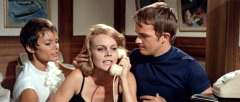 ORGASMO
was trimmed to six minutes from its original Italian cut when it was released
stateside as PARANOIA from Commonwealth United – the U.S. post-production
was by Synchrofilm editors Robert S. Eisen (INVASION OF THE BODY SNATCHERS)
and Stanley Frazen (THE MONKEES) who also retooled Jess Franco's VENUS IN FURS
and Massimo Dallamano's A BLACK VEIL FOR LISA for Commonwealth United, with
additional dialogue by Malvin Wald (THE NAKED CITY) who was responsible for
James Darren's hip narration in the Franco film ("Man it was a wild scene,
but if they wanted to go that route, it was their bag") – however,
that X-rated version added some nude takes of Baker to her shower scene, a slightly
more lingering shot when she rips open her robe in the garden, and Descombes
reveals more in a shot in bed with Baker than she does in the Italian version.
The film was released on panned and scanned VHS from NTA Entertainment sister
label Spotlite Home Video. When the Italian version did first turn up, it was
as a subtitled version shown on the Australian SBS TV station but the image
was incompletely letterboxed. When 01 Distribution in Italy put out a DVD, they
simply recycled the same non-anamorphic, incompletely letterboxed transfer minus
the subtitles. Severin's Blu-ray features separate 1080p24 MPEG-4 AVC 2.35:1
widescreen presentations of the Italian version (97:00) and the American version
(90:58). Sourced from fifty-year-old internegatives, both versions look softer
as the result of the 2-perf to 4-perf optical conversion when compared to some
other Technsicope gialli with scans source from the original 2-perf negatives.
The dullness of the colors is largely due to the wardrobe and décor choices
since some reds do pop when they turn up, but there are better-looking films
to come in this set. The Italian version includes the Italian mono track in
DTS-HD Master Audio 2.0 and an English DTS-HD Master Audio 2.0 mono track that
reverts to Italian for undubbed passages (a chunk of the ending) with the choice
of full SDH subtitles for the English track, full English subtitles for the
Italian track, and subtitles for just the Italian spots on the English audio
track. The American version features the mono mix in DTS-HD Master Audio 2.0
with an SDH subtitle track.
ORGASMO
was trimmed to six minutes from its original Italian cut when it was released
stateside as PARANOIA from Commonwealth United – the U.S. post-production
was by Synchrofilm editors Robert S. Eisen (INVASION OF THE BODY SNATCHERS)
and Stanley Frazen (THE MONKEES) who also retooled Jess Franco's VENUS IN FURS
and Massimo Dallamano's A BLACK VEIL FOR LISA for Commonwealth United, with
additional dialogue by Malvin Wald (THE NAKED CITY) who was responsible for
James Darren's hip narration in the Franco film ("Man it was a wild scene,
but if they wanted to go that route, it was their bag") – however,
that X-rated version added some nude takes of Baker to her shower scene, a slightly
more lingering shot when she rips open her robe in the garden, and Descombes
reveals more in a shot in bed with Baker than she does in the Italian version.
The film was released on panned and scanned VHS from NTA Entertainment sister
label Spotlite Home Video. When the Italian version did first turn up, it was
as a subtitled version shown on the Australian SBS TV station but the image
was incompletely letterboxed. When 01 Distribution in Italy put out a DVD, they
simply recycled the same non-anamorphic, incompletely letterboxed transfer minus
the subtitles. Severin's Blu-ray features separate 1080p24 MPEG-4 AVC 2.35:1
widescreen presentations of the Italian version (97:00) and the American version
(90:58). Sourced from fifty-year-old internegatives, both versions look softer
as the result of the 2-perf to 4-perf optical conversion when compared to some
other Technsicope gialli with scans source from the original 2-perf negatives.
The dullness of the colors is largely due to the wardrobe and décor choices
since some reds do pop when they turn up, but there are better-looking films
to come in this set. The Italian version includes the Italian mono track in
DTS-HD Master Audio 2.0 and an English DTS-HD Master Audio 2.0 mono track that
reverts to Italian for undubbed passages (a chunk of the ending) with the choice
of full SDH subtitles for the English track, full English subtitles for the
Italian track, and subtitles for just the Italian spots on the English audio
track. The American version features the mono mix in DTS-HD Master Audio 2.0
with an SDH subtitle track.
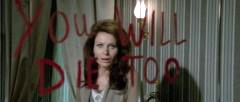
Unreleased in the United States despite the presence of Baker and Trintignant, SO SWEET… SO PERVERSE was long available only as a boot of an English-dubbed, Greek-subtitled tape. A handsome anamorphic widescreen transfer turned up on DVD in Italy but it was not English-friendly. Severin's 1080p24 MPEG-4 AVC 2.35:1 widescreen transfer from the original camera negative has some grainy night exteriors and interiors – the only really glaring compression issues occur briefly in the night scenes during some bits of fast motion – but the image is generally clean and crisp, and the greater attention to color choices is apparent here in wardrobe, décor, and the deployment of the color red from filters, gels, to blood and threats scrawled in lipstick. Italian and English DTS-HD Master Audio 2.0 mono tracks are included, along with English and English SDH subtitles tracks, with the English track restoring a final line of dialogue missing from the Greek tape.
 After
its theatrical release from Commonwealth United, A QUIET PLACE TO KILL went
to television as part of the Avco Embassy package with nudity snipped and one
take replaced with a covered version. The R-rated version turned up in the early
eighties on VHS from Fox offshoot Magnetic Video, but the easier option to find
for a time was the Unicorn Video VHS which featured a squeezed and cropped transfer
of the TV print. An attractive anamorphic widescreen version turned up in Japan
and Italy on DVD but both only featured the Italian audio track. The 2K scan
that Severin used for their Blu-ray first appeared on Blu-ray in Germany (in
Italian and German only) and then in the U.K. from 88 Films with the English
track last year. The 1080p24 MPEG-4 AVC 2.35:1 widescreen transfer is the best-looking
of the set from the color negative-printed credits onwards, free of any distracting
damage and featuring healthy skin tones and some nicely-saturated hues in the
wardrobe and locations (particularly the red-gelled grotto). The English and
Italian DTS-HD Master Audio 2.0 mono tracks – with optional English subtitle
translation and English SDH transcription – reveal some differences in
the dialogue (Dolenz becomes "Albert Duchamps" on the Italian track
despite the Spanish setting of the film).
After
its theatrical release from Commonwealth United, A QUIET PLACE TO KILL went
to television as part of the Avco Embassy package with nudity snipped and one
take replaced with a covered version. The R-rated version turned up in the early
eighties on VHS from Fox offshoot Magnetic Video, but the easier option to find
for a time was the Unicorn Video VHS which featured a squeezed and cropped transfer
of the TV print. An attractive anamorphic widescreen version turned up in Japan
and Italy on DVD but both only featured the Italian audio track. The 2K scan
that Severin used for their Blu-ray first appeared on Blu-ray in Germany (in
Italian and German only) and then in the U.K. from 88 Films with the English
track last year. The 1080p24 MPEG-4 AVC 2.35:1 widescreen transfer is the best-looking
of the set from the color negative-printed credits onwards, free of any distracting
damage and featuring healthy skin tones and some nicely-saturated hues in the
wardrobe and locations (particularly the red-gelled grotto). The English and
Italian DTS-HD Master Audio 2.0 mono tracks – with optional English subtitle
translation and English SDH transcription – reveal some differences in
the dialogue (Dolenz becomes "Albert Duchamps" on the Italian track
despite the Spanish setting of the film).
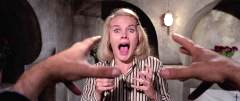
Unreleased in the United States or the United Kingdom, KNIFE OF ICE first became widely available in English-friendly form as a Japanese non-anamorphic letterboxed DVD that was watchable for the time. Earlier this year, French boutique label Le Chat Qui Fume put out a Blu-ray/DVD combo edition with an English audio track but no English translation for its pair of Lenzi interviews. Severin's 1080p24 MPEG-4 AVC 2.35:1 widescreen Blu-ray likely comes from the same scan of the original Techniscope camera negatives as the French edition. While a more attentive encode might have eked out some more sharpness, the variability of the image is largely down to the production with the grabbed bullfight under the opening titles softened by the long lenses and coarsened by the credits opticals while some exterior shots even in broad daylight are captured with smoke and fog machines running while others in the same scene are captured with glass fog filters. The interiors generally look best even in the slightly grainier dark scenes while the blacks in the night exteriors are often more grayish. English and Italian DTS-HD Master Audio 2.0 mono tracks are included with some additional offscreen dialogue in a couple scenes on the latter, and optional English subtitles and SDH subtitles.
 The
Italian version of ORGASMO is accompanied by an audio commentary by film historian
Alexandra Heller-Nicholas in which she notes her fondness for the Wes and the
Airdales song, and attempts to rehabilitate the perception of journeyman director
Lenzi as lesser than some of the auteurs associated with the genre – indeed
noting his greater versatility as a director than some specialists – and
credits Lenzi as the creator of this particular jet set variant of the giallo.
She also provides detail on Baker's Hollywood career and personal life at the
time she fled to Italy, her divorce, accepting her first Italian role in Marco
Ferreri's HER HAREM to put her children in a Swiss boarding school, and her
and Lenzi's assessments of each other. Of the film, she notes how the film embodies
the theme of internationalization and transcultural flow from its Pan Am arrival
opening to its American characters living it up (and down) in Rome. She also
discusses the influences of the French thrillers on Lenzi's giallo variant as
well as providing some context of Lenzi's earlier film credits. The X-rated
American version PARANOIA is accompanied by an audio commentary by Mondo-Digital's
Nathaniel Thompson and Troy Howarth, author of "So Deadly So Perverse:
50 Years of Italian Giallo Films" in which they discuss the PARANOIA title
confusion and that the film was actually intended as a prestige picture despite
its X-rating (Commonwealth United also put out 99 WOMEN and VENUS IN FURS with
X-ratings). They discuss the differences between the Italian and American cuts,
discuss Baker's performance, and puzzle over whether Castel is effective or
not in his part. The late Lenzi appears in "Giallo Fever" (11:01)
in which he discusses working with Baker, the international co-production –
the credit for future French director Bertrand Tavernier (A SUNDAY IN THE COUNTRY)
as assistant director is a quota credit (Tavernier actually did work on some
French/Italian co-productions under Riccardo Freda and hired him to work on
BEATRICE and REVENGE OF THE MUSKATEERS later in life) – and regards it
as one of his favorite films (noting that audiences were still surprised by
the ending when it was screened a couple years ago at the Venice Film Festival.
He also notes that the original title was indeed PARANOIA but the producers
wanted the ORGASMO title, so he reused the PARANOIA title for the film that
would be released here as A QUIET PLACE TO KILL. The disc also includes the
film's U.S. theatrical trailer (1:44).
The
Italian version of ORGASMO is accompanied by an audio commentary by film historian
Alexandra Heller-Nicholas in which she notes her fondness for the Wes and the
Airdales song, and attempts to rehabilitate the perception of journeyman director
Lenzi as lesser than some of the auteurs associated with the genre – indeed
noting his greater versatility as a director than some specialists – and
credits Lenzi as the creator of this particular jet set variant of the giallo.
She also provides detail on Baker's Hollywood career and personal life at the
time she fled to Italy, her divorce, accepting her first Italian role in Marco
Ferreri's HER HAREM to put her children in a Swiss boarding school, and her
and Lenzi's assessments of each other. Of the film, she notes how the film embodies
the theme of internationalization and transcultural flow from its Pan Am arrival
opening to its American characters living it up (and down) in Rome. She also
discusses the influences of the French thrillers on Lenzi's giallo variant as
well as providing some context of Lenzi's earlier film credits. The X-rated
American version PARANOIA is accompanied by an audio commentary by Mondo-Digital's
Nathaniel Thompson and Troy Howarth, author of "So Deadly So Perverse:
50 Years of Italian Giallo Films" in which they discuss the PARANOIA title
confusion and that the film was actually intended as a prestige picture despite
its X-rating (Commonwealth United also put out 99 WOMEN and VENUS IN FURS with
X-ratings). They discuss the differences between the Italian and American cuts,
discuss Baker's performance, and puzzle over whether Castel is effective or
not in his part. The late Lenzi appears in "Giallo Fever" (11:01)
in which he discusses working with Baker, the international co-production –
the credit for future French director Bertrand Tavernier (A SUNDAY IN THE COUNTRY)
as assistant director is a quota credit (Tavernier actually did work on some
French/Italian co-productions under Riccardo Freda and hired him to work on
BEATRICE and REVENGE OF THE MUSKATEERS later in life) – and regards it
as one of his favorite films (noting that audiences were still surprised by
the ending when it was screened a couple years ago at the Venice Film Festival.
He also notes that the original title was indeed PARANOIA but the producers
wanted the ORGASMO title, so he reused the PARANOIA title for the film that
would be released here as A QUIET PLACE TO KILL. The disc also includes the
film's U.S. theatrical trailer (1:44).

SO SWEET… SO PERVERSE is accompanied by an audio commentary by Kat Ellinger, author of "All the Colors of Sergio Martino", in which she also argues for Lenzi's talent in the genre and notes that directors working in different trending genres was the norm (while specialists like Argento and Bava were the exception) and that the productions were the bread and butter of Italian cinema. She discusses Lenzi's camera style, how his favoring wide shots that take in the settings objectively with conservative and effective uses of close-ups aides in the shift in point of view from one character in the first two acts to another in the last third less to be jarring. She also gives an appreciation of Trintignant's ability to inhabit characters in films on both the highbrow and lowbrow ends of cinema, and draws parallels between his character here and in Questi's wilder DEATH LAID AN EGG. In "Lenzi’s Lenses" (9:05), a chat with Lenzi at The 1999 Nocturno Film Festival, he stresses the influence of Clouzot as well as American directors Raoul Walsh, Samuel Fuller, and Don Siegel. Of the film, he notes that the third act is less interesting without Trintignant, and that the multiple twists are too contrived but he seems otherwise favorable of the film. Screenwriter Ernesto Gastaldi (ALL THE COLORS OF THE DARK) appears in the brief interview "Equilateral Triangle" (5:59) which takes its title from the story concept he submitted as a youth to a TV station that later became SO SWEET… SO PERVERSE but speaks less of the film itself than of his rocky relationship with Lenzi. The disc also includes the film's Italian credits sequence (2:26) and almost identical English and subtitled Italian theatrical trailers (3:26 and 3:25, respectively). An Easter Egg features an Italian TV interview with Baker (7:30) in which her English responses have been overdubbed in Italian but English subtitles are included for questions and answers.
 A
QUIET PLACE TO KILL is accompanied by an audio commentary by author and critic
Samm Deighan in which she also notes that Lenzi is harder to nail down than
other genre specialists, the influence of French sexy thrillers on his brand
of giallo, the themes and tropes common to Lenzi's gialli; indeed, she notes
the shuffling of situations and character between the film as part of how the
various Italian genre trends operated. In "Sex and Conspiracy" (10:51),
Lenzi discusses his use of the jet set in the giallo, dialing back the twists
from the previous film, its reception, and provides recollections of shooting
in Franco-era Spain where he was arrested three times during production as an
anarchist when visiting Spanish Civil War sites, and also noting that this wife
was not even allowed in the country because she was Yugoslavian. While the shower
scene was cut from the TV version, one alternate clothed scene (0:26) covered
up Baker's bare behind in bed. An extended scene (0:10) is a small extension
in the English version sourced from VHS and shown in context. The Italian credits
are also included with the negative effect reversed (2:07) which is interesting
to look at but spoiler-some even for those who have seen the film while the
negative version creates mystery and interest. The English version credits (2:08)
have been sourced from the Magnetic Video VHS tape and unsqueezed to 16:9. An
Easter Egg features an Italian TV location bit (1:02) on the film's St. Vincent
location shoot.
A
QUIET PLACE TO KILL is accompanied by an audio commentary by author and critic
Samm Deighan in which she also notes that Lenzi is harder to nail down than
other genre specialists, the influence of French sexy thrillers on his brand
of giallo, the themes and tropes common to Lenzi's gialli; indeed, she notes
the shuffling of situations and character between the film as part of how the
various Italian genre trends operated. In "Sex and Conspiracy" (10:51),
Lenzi discusses his use of the jet set in the giallo, dialing back the twists
from the previous film, its reception, and provides recollections of shooting
in Franco-era Spain where he was arrested three times during production as an
anarchist when visiting Spanish Civil War sites, and also noting that this wife
was not even allowed in the country because she was Yugoslavian. While the shower
scene was cut from the TV version, one alternate clothed scene (0:26) covered
up Baker's bare behind in bed. An extended scene (0:10) is a small extension
in the English version sourced from VHS and shown in context. The Italian credits
are also included with the negative effect reversed (2:07) which is interesting
to look at but spoiler-some even for those who have seen the film while the
negative version creates mystery and interest. The English version credits (2:08)
have been sourced from the Magnetic Video VHS tape and unsqueezed to 16:9. An
Easter Egg features an Italian TV location bit (1:02) on the film's St. Vincent
location shoot.
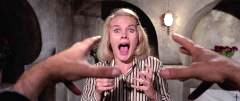
KNIFE OF ICE has no commentary but the Lenzi interview "Until the Silence Screams" (18:35) is the most satisfying of the four discs, with Lenzi noting his desire to do something different, taking inspiration from THE SPIRAL STAIRCASE and flipping the ending, and deliberately shying away from Argento-style violence. He discusses in detail the psychological make-up of the protagonist and various hints and clues he planted throughout the film, as well as noting his writing collaborator on the film Antonio Troiso (QUEENS OF EVIL) who died in his early thirties shortly after the film. In "Carroll and Umberto’s Final Stab" (29:06), "Nightmare USA" author Stephen Thrower notes that the film probably did not sell in the US and UK because it did not deliver what was expected of a Lenzi/Baker sexy thriller but he nevertheless expresses affection for the film and the entire genre's habit of sacrificing psychological realism for the effect of creating red herrings. The disc also includes the film's Italian credits sequence (2:27) with a far splashier title card, and an English theatrical trailer (3:05).
Housed with the ORGASMO disc is the heretofore previously-unreleased 21-track soundtrack CD – previously only the two theme songs were available as rare 45rpm singles – with the single version of "Fate Had Planned It So" as a bonus track. Housed with the SO SWEET… SO PERVERSE Blu-ray is the soundtrack reproducing the twenty track 2002 CD from Hexacord – although the tracks have been resequenced here as they appeared in the film – as well as including five tracks from A QUIET PLACE TO KILL (including two versions of "You") and a single track from KNIFE OF ICE since the master tapes of most of the Nazionalmusic ?seem to be lost or otherwise unavailable (the CD on the French Blu-ray is a compilation of themes from other giallo films). The handsomely-designed box housing the disc is limited to four thousand copies but each film has a separate UPC number so presumably they will be released separately (probably without the CDs since they are not mentioned on the covers). (Eric Cotenas)